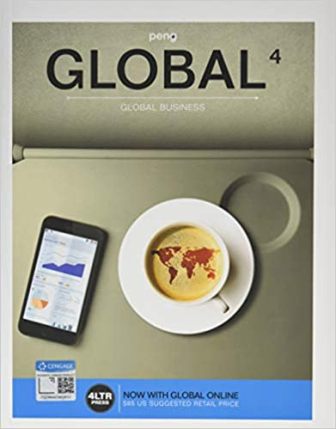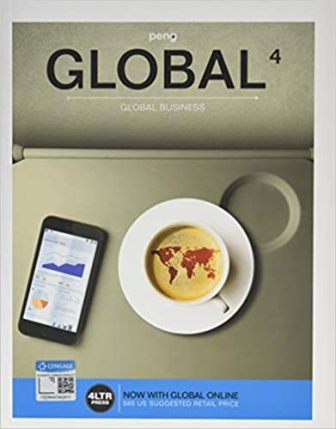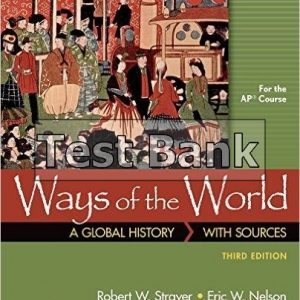This is completed downloadable of Test Bank for GLOBAL 4, 4th Edition, Mike Peng

Product Details:
- ISBN-10 : 133740683X
- ISBN-13 : 978-1337406833
- Author: Mike Peng
Through ongoing research into students workflows and preferences, GLOBAL from 4LTR Press combines an easy-reference, paperback textbook with Chapter Review Cards, and an innovative online experience – all at an affordable price. New for this edition, students explore GLOBAL anywhere, anytime, and on most devices with GLOBAL Online! With the intuitive StudyBits functionality, students study more effectively and can visually monitor their own progress. Coupled with straightforward course management, assessment, and analytics for instructors, GLOBAL with Online engages students of all generations and learning styles, and integrates seamlessly into your Global Business Course. GLOBAL4 features all-new animated PengAtlas maps, cutting-edge examples, and chapter introduction videos.
Table of Content:
- Part 1: Laying Foundations
- Chapter 1: Globalizing Business
- 1-1 What Is Global Business?
- 1-2 Why Study Global Business?
- 1-3 A Unified Framework
- 1-4 What Is Globalization?
- 1-5 A Glance at the Global Economy
- 1-6 Organization of the Book
- Chapter 2: Understanding Politics, Laws, & Economics
- 2-1 Understanding Institutions
- 2-2 What Do Institutions Do?
- 2-3 An Institution-Based View of Global Business
- 2-4 Political Systems
- 2-5 Legal Systems
- 2-6 Property Rights and Intellectual Property Rights
- 2-7 Economic Systems
- 2-8 Management Savvy
- Chapter 3: Emphasizing Cultures, Ethics, & Norms
- 3-1 Where Do Informal Institutions Come From?
- 3-2 Culture
- 3-3 Classifying Cultural Differences
- 3-4 Culture and Global Business
- 3-5 Ethics
- 3-6 Ethics and Corruption
- 3-7 Norms and Ethical Challenges
- 3-8 Management Savvy
- Chapter 4: Leveraging Resources & Capabilities
- 4-1 Understanding Resources and Capabilities
- 4-2 Resources, Capabilities, and the Value Chain
- 4-3 When and When Not to Outsource
- 4-4 From SWOT to VRIO
- 4-5 Management Savvy
- Part 2: Acquiring Tools
- Chapter 5: Trading Internationally
- 5-1 Why Do Nations Trade?
- 5-2 Theories of International Trade
- 5-3 Realities of International Trade
- 5-4 Management Savvy
- Chapter 6: Investing Abroad Directly
- 6-1 Understanding the FDI Vocabulary
- 6-2 Why Do Firms Become MNEs By Engaging in FDI?
- 6-3 Ownership Advantages
- 6-4 Location Advantages
- 6-5 Internalization Advantages
- 6-6 Realities of FDI
- 6-7 Management Savvy
- Chapter 7: Dealing with Foreign Exchange
- 7-1 What Determines Foreign Exchange Rates?
- 7-2 Evolution of the International Monetary System
- 7-3 Strategic Responses
- 7-4 Management Savvy
- Chapter 8: Capitalizing on Global & Regional Integration
- 8-1 Integrating the Globale Conomy
- 8-2 Organizing World Trade
- 8-3 Integrating Regional Economies
- 8-4 Regional Economic Integration in Europe
- 8-5 Regional Economic Integration in the Americas
- 8-6 Regional Economic Integration in the Asia Pacific
- 8-7 Management Savvy
- Part 3: Managing around the World
- Chapter 9: Growing & Internationalizing the Entrepreneurial Firm
- 9-1 Entrepreneurship and Entrepreneurial Firms
- 9-2 Institutions, Resources, and Entrepreneurship
- 9-3 Growing the Entrepreneurial Firm
- 9-4 Internationalizing the Entrepreneurial Firm
- 9-5 Management Savvy
- Chapter 10: Entering Foreign Markets
- 10-1 Overcoming the Liability of Foreignness
- 10-2 Where to Enter?
- 10-3 When to Enter?
- 10-4 How to Enter?
- 10-5 Management Savvy
- Chapter 11: Making Alliances & Acquisitions Work
- 11-1 Defining Alliances and Acquisitions
- 11-2 How Institutions and Resources Affect Alliances and Acquisitions
- 11-3 Formation of Alliances
- 11-4 Dissolution of Alliances
- 11-5 Performance of Alliances
- 11-6 Motives for Acquisitions
- 11-7 Performance of Acquisitions
- 11-8 Management Savvy
- Chapter 12: Strategizing, Structuring, & Learning around the World
- 12-1 Multinational Strategies and Structures
- 12-2 How Institutions and Resources Affect Multinational Strategy, Structure, and Learning
- 12-3 Worldwide Learning, Innovation, and Knowledge Management
- 12-4 Management Savvy
- Chapter 13: Managing Human Resources Globally
- 13-1 Staffing
- 13-2 Training and Development
- 13-3 Compensation and Performance Appraisal
- 13-4 Labor Relations
- 13-5 Institutions, Resources, and Human Resource Management
- 13-6 Management Savvy
- Chapter 14: Competing in Marketing & Supply Chain Management
- 14-1 Three of the Four Ps in Marketing
- 14-2 From Distribution Channel to Supply Chain Management
- 14-3 Triple As in Supply Chain Management
- 14-4 How Institutions and Resources Affect Marketing and Supply Chain Management
- 14-5 Management Savvy
- Chapter 15: Managing Corporate Social Responsibility Globally
- 15-1 A Stakeholder View of the Firm
- 15-2 Institutions, Resources, and Corporate Social Responsibility
- 15-3 Management Savvy
- Endnotes
- Index





